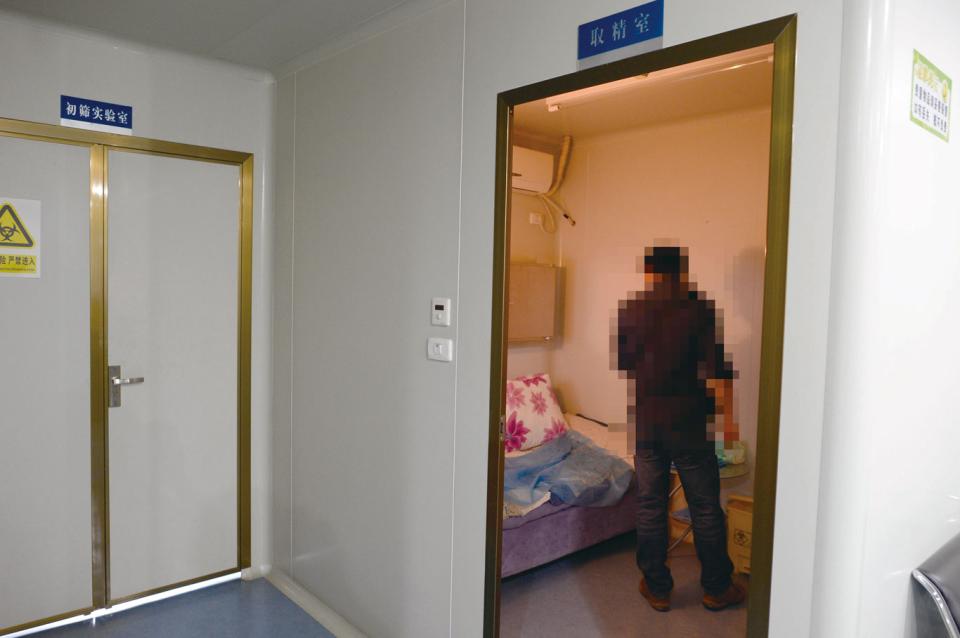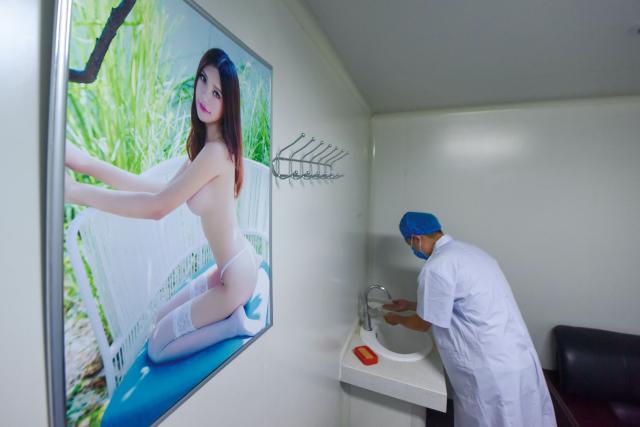At the Human Sperm Bank of Peking University Third Hospital (PUTH), sperm donors have to pass short interviews before entering the small “sperm extraction” room. In it, a sofa and table sit in the corner. Posters of scantily clad women hang on the wall. Collected sperm specimens have to pass several preliminary checks for chronic and sexually transmitted diseases.
If all checks out, approved donors will give 40 samples (or 20 millimeters) during seven or eight visits spaced over several months. The samples are cataloged and stored in liquid nitrogen containers at about -196 C. However, the whole process is completed half a year later, when the donor once again confirms negative for HIV.
More than 40 million Chinese are infertile, according to a survey by the China Population Association in 2012. Jiang Hui, director of urology at PUTH, is quick to point out this data is showing its age as China’s infertility rate continues to climb due to later marriages, food safety and changing lifestyles.
Issues for male infertility include low sperm motility, sperm malformation and obstruction of the vas deferens. Roughly 10 percent of infertile men have a condition that prevents them from producing sperm, even with surgery and medication. “You can’t do anything if there are no seeds in the fields,” Jiang told NewsChina.
The first human sperm bank was established in the US in the 1960s, which provided quick cash to college students in exchange for samples. It wasn’t until the rise of HIV in the 1980s that sperm banks were standardized. Meanwhile, sperm banks began to spring up in Beijing and some provinces such as Hunan. According to Chinese regulations, sperm banks are not commercial ventures. Donations are voluntary and considered a form of public service.
If an infertile couple seeks access to a sperm bank, the husband must first undergo a physical exam to confirm his infertility. The wife will then receive checkups to determine the best reproduction method. The couple must also sign a statement vowing not to violate China’s recently enacted two-child policy. If the wife is also infertile or artificial insemination proves ineffective after three attempts, in vitro fertilization is used.
There are 26 sperm banks nationwide approved by the National Health and Family Planning Committee, most of which operate within public hospitals. In the two years after its inception in 2016, PUTH conducted 2,000 assisted reproductive operations. That number is expected to double by the end of 2019.
PUTH spends roughly 10,000 yuan (US$1,450) on each successful donation including 5,000 yuan (US$730) in subsidies for donors and checkup fees. Jiang Hui said his hospital receives more than 10,000 sperm donations a year, 200 of which are from patients seeking to store sperm for their own future use. At US hospitals, he added, the proportion of cryogenic freezing for personal use averages around 80 percent of total collected samples. Jiang said that in China, a single donor’s sperm is limited to five women, a policy in place to prevent the possibility of accidental incest and other consanguineous outcomes. But in the US, sperm from one donor can impregnate up to 25 women. In 2016, 200,000 sperm samples were preserved in 24 sperm banks in China, but only half of them were used. The next year, only 90,000 of 190,000 samples were used.
On the other hand, sperm banks are having an increasingly hard time recruiting healthy donors. “A couple of years ago, 5,000 yuan (US$730) was a large sum of money for college students. Nowadays they’re unwilling to donate for that same amount, particularly when they have to come to the hospital many times,” Jiang said. The pass percentage for donors in Hunan Province alone dropped to 18 percent in 2015, down from 46 percent in 2006.
Decreasing sperm quality is also a universal trend. In the fifth edition of the WHO Laboratory Manual for the Examination and Processing of Human Semen released in 2010, criteria for acceptable semen were reduced compared to previous editions. Huang Hefeng, a professor of reproductive medicine at Shanghai Jiao Tong University School of Medicine, told our reporter that in the early 1980s, 20 percent of abnormal sperm morphology was the accepted standard. It is now 96 percent.
In 2003, China’s former Ministry of Health (National Health Commission) released regulations that prohibited unmarried women and couples that have violated China’s Family Planning Policy from assisted reproduction methods. The only exception is Jilin Province, which allows single women to receive fertility treatments.
Ma Yinan, a professor specializing in marriage and family law at the Peking University Law School, told NewsChina that while international conventions and domestic laws recognize the childbearing rights of single women, “these seemingly well-intended and vague clauses do not imply de facto empowerment.”
Ma argued that even if unmarried women purchase sperm and become pregnant abroad, they still have difficulties bypassing restrictions back home. For example, according to population and family planning regulations in many provinces, women who have a child out of wedlock face punishments. In some areas, women face fines, forced marriage and being fired.
During the National People���s Congress (NPC) in March 2019, Huang Xihua, an NPC deputy from Huizhou, Guangdong Province, advocated for protecting unmarried women’s childbearing rights and their children’s right to a hukou, or permanent residency permit. In recent years, more Chinese women have been heading overseas for assisted reproduction. As one of the world’s largest sperm banks, Cyros International Sperm Bank in Denmark receives online orders from more than 100 countries. All its sperm donors have a label, with details including educational background, height, profession and even a sound clip of the donor’s voice.
Ole Schou, founder of Cryos, told NewsChina that 60 percent of clients are single women who are usually highly selective and anxious about their situation. Most buyers are financially stable professionals with high educational backgrounds including doctors, engineers and lawyers, and are often late in their childbearing years.
Schou added that some Chinese buyers get around the stringent regulatory system by placing orders online and having sperm samples sent to clinics in neighboring countries and regions such as Cambodia and Singapore. These women undergo fertility treatment abroad before coming back to China to give birth.
“I’ve decided to try IVF. There are a variety of sperm banks worldwide with plenty of fine donors who are tall and have master’s degrees or even PhDs,” said one woman. “I have four apartments in a second-tier city in China and US$150,000 in cash. I made the decision after discussing it with my parents and girlfriend of more than 10 years.”
“It has become a worldwide trend to recognize the childbearing rights of single women. But it will take a long time for it to happen in China,” said Ma.
Ma argued that along with advancements in reproductive medicine, more varied family structures will follow. “The key lies in how to address concerns such as what affect the childbearing rights of single women and lesbians will have on traditional family structures,” he said. “A sweeping ban would be a last resort.”

 Old Version
Old Version
